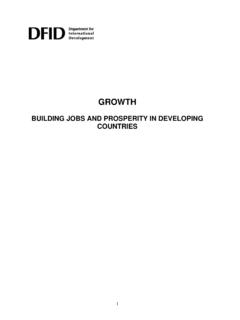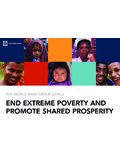Transcription of Poverty and inequality - fao.org
1 PART 2 Poverty and inequalityAmong the many determinants of hunger, Poverty is oneof the most important. But like hunger, Poverty too ismultifaceted. Not simply a lack of income or consump-tion, Poverty includes deprivation in health, education,nutrition, security, empowerment and dignity. Vulnera-bility constitutes a further dimension of Poverty . With-out effective coping mechanisms, excessive exposure toshocks such as drought and sudden price swings cre-ates the risk of future Poverty . All of these dimensionsinteract with and reinforce one another.
2 However, to fa-cilitate international comparison, Poverty indicators areusually confined to measuring the proportion of a popu-lation whoseincome is below a particular Poverty metrics tend to be absolute, inequality ,on the other hand, looks at the distribution of the met-ric ( income) in a population. For example, a high- inequality country might need twice as much economicgrowth as low- inequality countries to meet a Poverty , a major reason that people may not haveaccess to food even when enough is produced is thatthere is no guarantee that a market economy will gener-ate a distribution of income that provides enough for allto purchase the food needed.
3 Fighting hunger also helpsreduce Poverty , as undernourishment reduces labourproductivity, increases susceptibility to illness, worsensschool performance, reduces the willingness to under-take risky but more profitable investments and transmitsitself from one generation to the in the past three decades, tremendousprogress has been achieved in reducingincome povertyin certain parts of the world notably in China and otherparts of East Asia where Poverty incidence dropped from78 to 17 percent there remains an estimated bil-lion people who still live on less thanUS$ day (thepresent internationally accepted Poverty line).
4 Progressin Poverty reduction has been very uneven. Sub-SaharanAfrica, for example, has registered only a marginal de-cline. From a headcount perspective, the number of poorpeople living in the region nearly doubled and its shareof the world s poor increased from 11 to 27 percent dur-ing this thirty year monetary poor are particularly vulnerable to risingprices of food, with some groups spending over 80 per-cent of their income to meet sustenance needs. Froma broader perspective, roughly billion people inthe 104 countries covered by the United Nations De-velopment Programme s (UNDP) MPI (MultidimensionalPoverty index), representing one-third of their popula-tion, live inmultidimensional Poverty , which is indicatedby acute deprivation in health, education and the stan-dard of 27:No Data< 11 55 1010 20> 20 Poverty gap at $ a day PPP (%, 2009*)Source: World BankMetalink: , p.
5 169 Around billion people have less thanUSD per day Despite being high, the proportion of theworld s poor has fallen by half in recentdecades Progress is particularly driven by China110 Poverty AND INEQUALITYNo Data< 11 55 1010 20> 20 Poverty gap at $ a day PPP (%, 2009*)Chart 58: As a share of world population, Poverty is decreasingPoverty headcount ratio at $ a day - PPP (2005)% of population303540455019851990199520002005 Source: World BankMetalink: , p. 168111 PART 2 According to the agency, over half the world s multidi-mensionally poor live in South Asia (844 million peo-ple), and more than a quarter live in Africa (458 mil-lion), which also has the highest incidence of multidi-mensional many societies there are groups, especially ruralwomen, youth, indigenous peoples and ethnic minoritiesthat face deeply rootedinequalities.
6 Gender inequalitiesare very pronounced in sub-Saharan Africa, South Asiaand the Near East and North Africa. The agricultural sec-tor is a case in agriculture and rural ar-eas have one thing in common across regions: they haveless access than men to productive resources and op-portunities. The gender gap is found in the case of manyassets, inputs and services land, livestock, labour, edu-cation, extension and financial services, and technology and it imposes costs on the sector, the broader econ-omy and society, as well as on the women the world, rising income inequality is the norm:more countries have a higherGini coefficientnow than inthe 1980s.
7 For each country where inequality has fallenin the last 20 to 30 years, it has worsened in more thantwo others. The majority of countries in East Asia haverising income inequality . To an extent, this can be ex-plained by widening disparities between rural and ur-ban populations, owing to rapid industrialization and in-creasing returns to higher levels of schooling. In sub-Saharan Africa, inequality has substantially improved,coinciding with the period of economic growth that be-gan more than a decade America and the Caribbean, traditionally a regionof high inequality related to unequal land distribution,regressive public spending and uneven access to educa-tion, has made rapid progress in recent decades.
8 This isespecially true of Brazil, Ecuador and Paraguay. Greaterequality is associated with structural economic changesthat have brought women into employment and to af-firmative measures designed to equalize access to edu-cation. The challenge is to create conditions that allowthe poor to escape Poverty and, in doing so, ensure thatopportunities are reading UNDP - Human Development Report 2010. The RealWealth of Nations: Pathways to Human Development( ) IFAD Rural Poverty Report. New realities, new chal-lenges, new opportunities for tomorrow s generation( ) World Bank Poverty Reduction and Equity Group( )Chart 59: Countries in sub-Saharan Africa have the low-est human development index adjusted for inequalityInequality-adjusted HDI score (2010)IndexZimbabweCongo, Dem.
9 African RepublicLiberiaMaliSierra LeoneBurkina FasoGuineaEthiopiaGambiaHaitiComorosAngo laRwandaNigeriaDjiboutiC te d IvoireMalawiSenegalZambiaMauritaniaBenin LesothoTanzania, Utd. , PDRM icronesia (Federated States of)Bolivia (Plur. State) : UNDP-HDRM etalink: , p. 166112 Poverty AND INEQUALITYMap 28: Income inequality prevalent throughout the worldNo Data< 3030 4040 4545 50> 50 Gini score of income distribution, higher scores reflect higher inequality (index, 2009*)Source: World BankMetalink: , p. 168 Map 29.
10 And so is gender inequalityNo Data< > inequality score, higher scores reflect higher inequality (Index, 2008)Source: World BankMetalink: , p. 166113 PART 2 Good governanceFormer UN Secretary General Kofi Annan once said goodgovernance is perhaps the single most important factorin eradicating Poverty and promoting development . Ef-forts to promote agricultural development and food se-curity in countries where they are most needed are oftenhindered by a lack of good put, governance means the process of decision-making and how decisions are implemented (or not im-plemented).


















